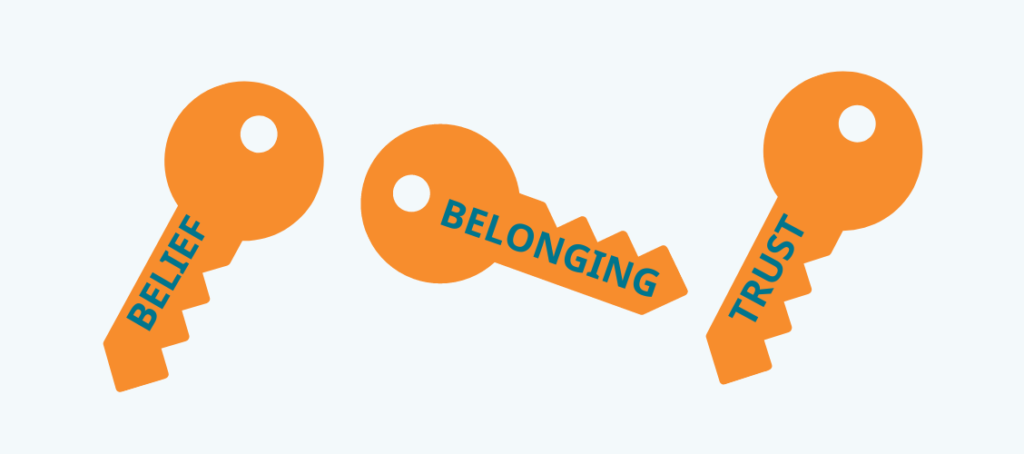The average person will spend 90,000 hours at work over their lifetime.[1] That’s 90,000 hours filled with the potential for engagement, growth, and satisfaction—or stress, exhaustion, and burnout. Your work life has a profound effect on your mental health. Whether that effect is positive or negative depends on your workplace culture.
Culture is always there—whether or not you talk about it or intentionally create it. And it has a huge impact on nonprofit organizations. At nonprofits, culture is not only experienced by your employees, but by your donors and volunteers. It should inspire all of these people just as much as your mission does.
But what is workplace culture? Simply put, culture encompasses your organization’s shared values and group norms.[2] It’s how every person in your organization behaves, treats each other, and interacts with the people you serve.[3] And when it is in harmony with your team members’ individual principles, it will create an environment in which your employees can thrive.
Here are four signs of a happy, healthy nonprofit workplace culture:
1. Everyone on your team knows your mission.
It sounds simple, but it is vital. You can’t be enthusiastic about what you don’t know, and enthusiasm is critical to nonprofit work. When your team understands your mission, they know that their work makes a difference.
Engaged employees become advocates for your cause. Nonprofits work hard to make sure that people know what they do. They aim to touch hearts and minds, to move donors, funders, and volunteers to join them in their work. Employees who feel a sense of ownership of this work are the best endorsement you could ask for.
2. Your leaders embody your values in and outside of your workplace culture.
People learn by example. Leaders who model the behavior they expect earn the respect of their team, and anyone can be a cultural leader. Write your organization’s values on a sticky note and put them on your desk or computer monitor. At the end of the day, reflect on the ways you lived them out, and incorporate them consciously into your daily routine until they become second nature. And don’t forget to applaud your team members when you observe them living out these values, too.
When an organization looks for a volunteer leader like a campaign chair, they ask individuals who inspire the people around them with their consistent service and generosity. They are great ambassadors for the organization. Every nonprofit team member needs to see that kind of dedication in action.
3. Team members get to do what they are good at every day within your workplace culture.
We gain energy and joy when we do what comes naturally to us. There is nothing quite like the satisfaction of contributing your unique gifts to a project or mission. Teams work more effectively together when they understand and appreciate what each member has to offer.
At Cramer, we are huge fans of the Working Genius model established by Patrick Lencioni, an assessment that gauges the ways individuals contribute to a team. Not only do all of us know our own areas of genius, competency, and frustration, but we know our colleagues’ as well, and we make an effort to bring them into projects when we know that their skills are needed most. This gives everyone a sense of pride in the finished product, and gives us a greater appreciation for what we can do together.
4. Your team knows they are appreciated within your workplace culture.
Great nonprofits constantly thank donors because it keeps them engaged. Volunteers who live out an organization’s mission receive credit. Acts of appreciation encourage them and inspire others.
The same goes for employees. A great work culture is one in which gratitude is expressed consistently. Devote time during staff meetings to acknowledge recent accomplishments, and plan regular celebrations so employees have a chance to unplug. That way, they have the motivation to tackle that next big project, event, or campaign phase!
To paraphrase Will Durant, “Culture is what we repeatedly do.” It is more than a proclamation of values—it is the way we live out those values every day.
Building a culture is also a group effort—just like the change your organization wants to make in the world! Individual words and actions might seem insignificant, but together they add up to so much more. Within a healthy culture, employees find the support and satisfaction that they need to be resilient and successful.
[1] https://www.gettysburg.edu/news/stories?id=79db7b34-630c-4f49-ad32-4ab9ea48e72b
[2] https://hbr.org/2018/01/the-leaders-guide-to-corporate-culture
[3] https://www.forbes.com/sites/forbesnonprofitcouncil/2021/01/06/a-leadership-lesson-nonprofit-leaders-must-learn-company-culture-is-more-important-than-you-think/?sh=45ab095c6ac6






